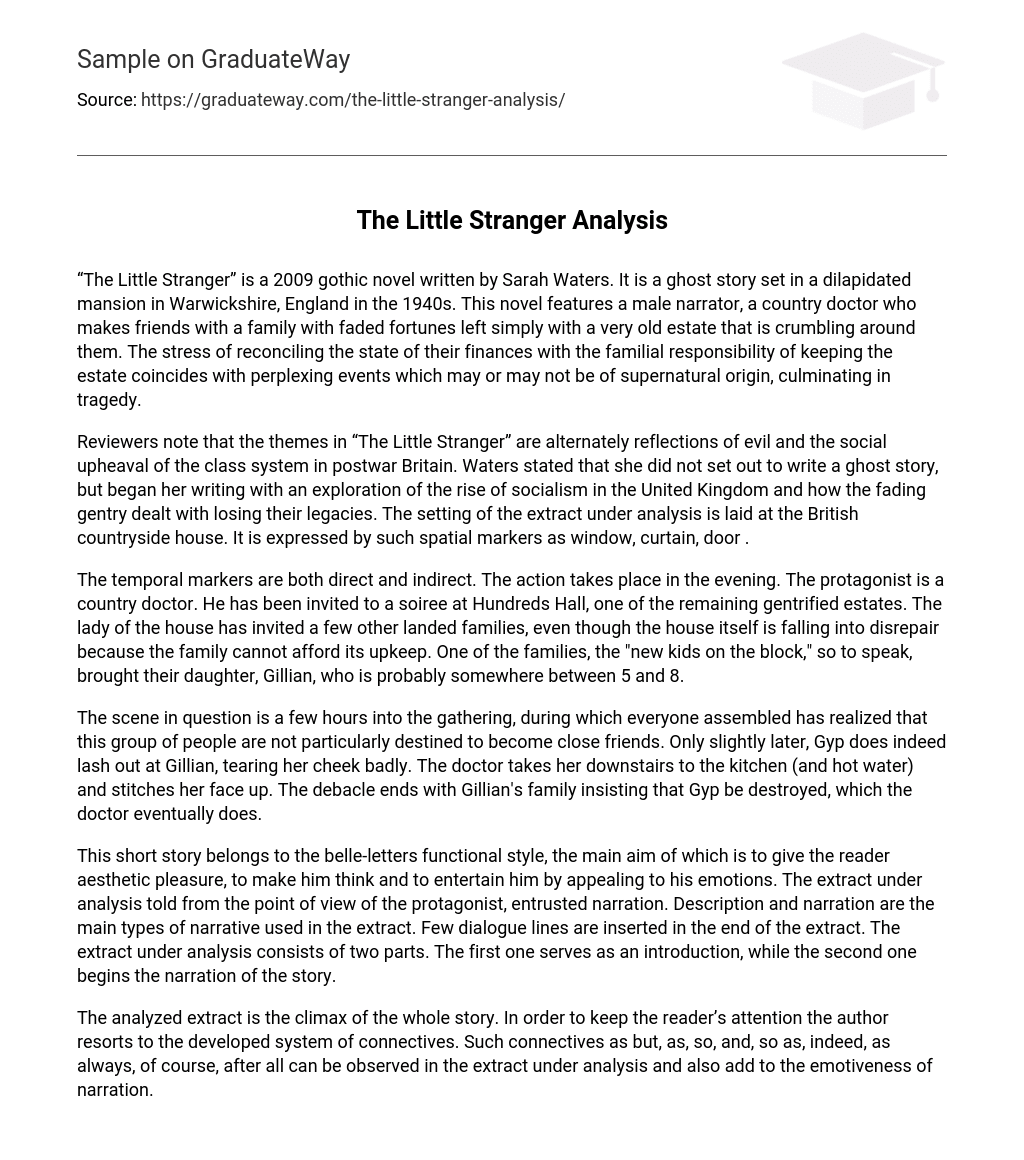“The Little Stranger” is a gothic novel by Sarah Waters published in 2009. It is set in a dilapidated mansion in Warwickshire, England during the 1940s and follows the story of a male narrator, a country doctor. The doctor forms a friendship with a family who are facing financial difficulties and dealing with the decay of their ancient estate. Alongside their struggle to preserve their ancestral home, they experience unexplained phenomena which could be supernatural, ultimately resulting in a tragic ending.
Reviewers of “The Little Stranger” observe that the themes present in the book are both manifestations of evil and the societal turmoil caused by the class system in postwar Britain. Sarah Waters, the author, explains that her intention was not to write a ghost story, but rather to delve into the emergence of socialism in the United Kingdom and how the declining upper class coped with the loss of their inheritances. The passage being studied takes place in a rural British mansion, as indicated by spatial elements like windows, curtains, and doors.
The temporal markers in the text are both direct and indirect, indicating that the action occurs in the evening. The protagonist is a country doctor who has been invited to a soiree at Hundreds Hall, a gentrified estate that is falling into disrepair. The lady of the house has invited other landed families, including a new family who brought their daughter, Gillian, who is estimated to be between 5 and 8 years old.
During a gathering, it becomes clear to everyone that the group of people assembled are not meant to be close friends. After some time, Gyp lashes out at Gillian, causing a deep tear on her cheek. The doctor takes Gillian to the kitchen where he stitches up her face using hot water. Finally, Gillian’s family demands that Gyp be put down, and eventually, the doctor complies with their request.
This short story belongs to the belle-letters functional style, which aims to provide aesthetic pleasure to the reader while making them think and appealing to their emotions. The extract being analyzed is narrated from the protagonist’s perspective and combines both description and narration. It is divided into two parts, with the first one serving as an introduction before the story’s narration begins. Some dialogue lines are included towards the end of the extract.
The analyzed extract represents the culmination point of the entire story. To maintain the reader’s engagement, the author employs an elaborate system of connectives. These connectives include but, as, so, and, so as, indeed, as always, of course, and after all. Their presence in the analyzed extract contributes to the heightened emotional impact of the narrative. With a focus on emotions, the passage abounds with various stylistic devices. Notably, the text extensively employs epithets such as gentlest, horrible, thin, low, liquid, poor, loose, shattering, trembling, desperate, rigid, vivid, ghastly, and terrified.
The author utilizes epithets to improve the figurative language and enhance the speech, thereby establishing an atmosphere of a destructive disaster. The stylistic device of detachment is employed by the author to depict the protagonist’s inner thoughts, which are seen multiple times in subsequent months. I acknowledged these instances with something insignificant, but it added to the overall tone. Both individuals were wearing evening clothes stained with blood, similar to everyone else present.
The narrative’s expressiveness is enhanced by the use of metaphor. Throughout the evening, I hardly spoke to them and Mr. Baker-Hyde was let down when one of them tripped over a loose carpet seam. Hyperbole is also employed as a stylistic device to emphasize this point: I will forever recall this moment. At the start of the passage, lengthy and intricate sentences are mainly used. Ever since she arrived, she pretended to be frightened of Gyp by seeking refuge behind her mother whenever he approached.
However, in the second part, the author uses short simple sentences to express the shock and condition of the main characters. For example, Gyp had bitten her and the poor child was white and rigid with shock. This technique creates a contrast between the calmness at the start of the evening and the atmosphere of disaster later on. Although the author’s narration dominates in this passage, there are also a few lines of dialogue, mostly presented as short queues like “Look at her!” and “I’ll need water.”
The author uses lexical repetitions in the dialogue lines, such as “Christ! Christ! Look at the state of her!” The purpose of these repetitions is to convey a sense of shock and the tragic atmosphere. The first two paragraphs of the text extensively employ stylistic devices to create a tense atmosphere. The analysis of the text reveals its emotive nature, evoking a sense of terror in the reader.





